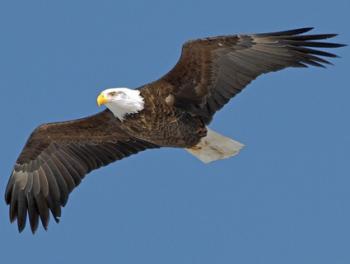Bald eagles of Lincoln County
If it seems like you are seeing a lot more bald eagles in Lincoln County, it’s not your imagination.
Not that long ago, a bald eagle sighting was cause for excited comment. Today it’s almost an everyday occurrence, and that’s by design, said Erynn Call, State Raptor Specialist with the Maine Department of Inland Fisheries and Wildlife.
“In the mid-70s, there were 30 nesting pairs in Maine,” she said. “Today, there are over 633 nesting pairs, and those are the only ones we count. We don’t count juveniles, or lone adults, or bachelor groups.”
Call said that the ban of DDT, a chemical which weakened the eggshells of birds, was the beginning of an effort to bring back the bald eagle from the brink of extinction. DDT was banned in 1972. But habitat loss was also a risk for the large raptors. It became necessary to provide connected habitat, safe from development, so the eagles and other raptors could once again soar in Maine’s skies.
This was done by a series of agreements and easements with landowners. The properties adjacent to already protected areas, such as Acadia National Park, state parks, and land trusts, were very valuable to provide a greater protected territory for the eagles. Each nesting pair can require quite a large hunting territory, almost always near a body of water or the ocean. Most eagles prefer fish, but will also eat turtles and other reptiles, small mammals, other birds, and even carrion. They also require trees that can support their nests, the largest tree nest of any animal on earth, some up to 10 feet across and 20 feet deep.
The effort was remarkably successful. Call said that while the annual population change for nesting pairs in Maine was seven percent across all counties, coastal regions, including the Midcoast, saw increases of nine percent or more, while fewer were added to the western mountains. In the west, the numbers are not growing as steadily because efforts to increase habitat have not been as successful as they have been along the coast and in central Maine.
The effort to save the bald eagle have helped other raptors as well. The Midcoast has seen an increase in populations of osprey, for instance, and although no official count has been conducted, a survey of nesting sites suggests there are more peregrine falcons in the region than existed before the mid-70s as well. Turkey vultures and many species of owl have benefited from efforts to save the bald eagle.
The increase in nesting pairs has caused the bald eagle to be de-listed from the Endangered Species list to a State Species of Special Concern. Its cousin, the golden eagle, is still considered an endangered species, however. The next statewide survey for bald eagles will occur in 2018.






























